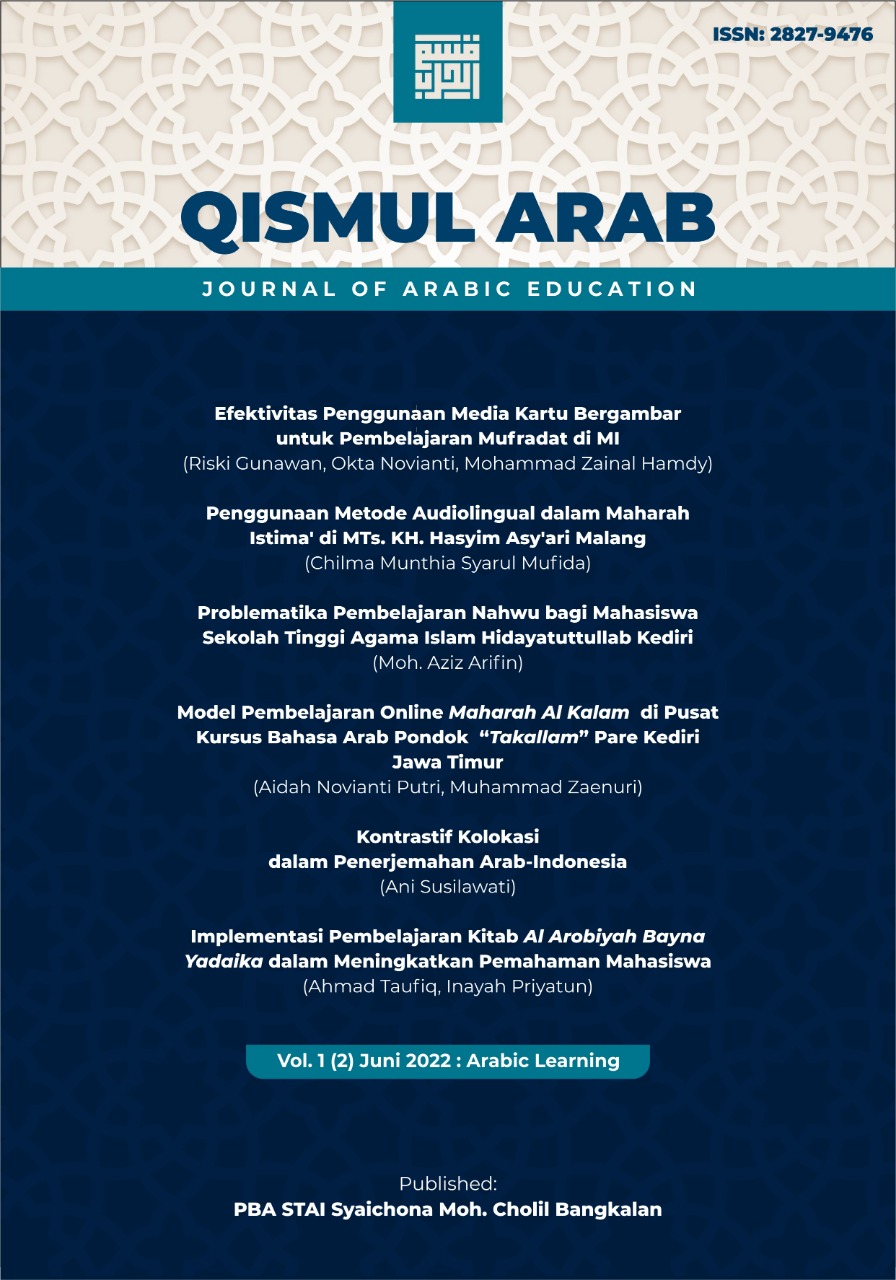Efektivitas Penggunaan Media Kartu Bergambar Untuk Pembelajaran Mufradat Di MI
DOI:
https://doi.org/10.62730/qismularab.v1i02.7Abstract
This study aims to determine the effectiveness of using picture card media for mufradat learning at MI Al-Istiqomah Banjit Way Kanan after the development and validation process of the product. Researchers are interested in developing this media because mufradat learning at MI is still using conventional media, so there is a need for media that can assist in mufradat learning at MI Al-Istiqomah Banjit Way Kanan. This study uses the type of research and development (Research and Development) or R&D, namely the research method used to produce a particular product and test the feasibility of the product. Using the ADDIE model developed by Dick and Carry, it is arranged programmatically with systematic sequences of activities in an effort to solve learning problems related to learning resources, needs and learning characteristics. This model consists of five steps, namely: Analysis (analyze), Design (design), Development (development), Implementation (implementation) and Evaluation (evaluation). However, in this study, the researchers only discussed the effectiveness of using picture card media after the expert validation process and product testing. The research instrument used was a questionnaire. While the data analysis technique used is descriptive data analysis technique, namely by describing the effectiveness of using picture card media in mufradat learning. Based on the results of data analysis, after going through the process of product validation and testing and responses from student questionnaires, 80% were in the very effective category. So it can be concluded that the media is feasible, effective and can be used as a supporting medium for learning Arabic, especially mufradat.
References
Alamsyah, Said dan Andi Budimanjaya. 2015. 95 Strategi Mengajar Multiple Intelligences. Jakarta: Kencana
Assyauqi, Moh. Iqbal. Pengembangan Media Pada Pembelajaran Kosa Kata Bahasa Arab Berbasis Komputer Menurut Konsep Teknologi Pembelajaran.
Azhar Arsyad. 2010. Bahasa Arab dan Metode Pengajarannya. Yogyakarta: Pustaka Pelajar.
Badriyah. 2015. Efektifitas Proses Pembelajaran Dengan Pemanfaatan Media Pembelajaran Jurnal Lentera Komunikasi Vol.1 No.1
Daryanto. 2011. Media Pembelajaran.(Bandung: Satu Nusa)
Hasil wawancara dengan guru bidang studi dan siswa kelas IV (15 juli 2020)
Jalinus, Nizwardi dan Ambiyar. 2016. “Media dan Sumber Pembelajaran”, (Jakarta: Kencana)
Mardhiah, Ainun dan Said Ali Akbar. 2018. Efektivitas Media Pembelajaran Terhadap Hasil Belajar Kimia Siswa Sma Negeri 16 Banda Aceh. Lantanida Journal. Vol. 6
Munawir, Ahmad Warsun. 2002. Kamus Al – Munawir Arab- Indonesia, cet. Kedua, (Surabaya: Pustaka Progresif)
Muslim, M. Tantowi Jauhari. 2017. Penggunaan Kitab Durusullughoh Al-Arobiyah Dalam Pembelajaran Bahasa Arab Siswa Kelas Viii Mqwh (Madrasatul Qur’an Wal-Hadits) Al-Aziziyah Kapek Gunungsari Lombok Barat T.A 2016/2017, (Mataram, UIN mataram )
Nugrawiyati, Jepri. 2018. Media Audio-Visual Dalam Pembelajaran Bahasa Arab, (Madiun)
Nugrawiyati, Jepti. 2018 “Media Audio-Visual dalam Pembelajaran Bahasa Arab”
Nuha, Ulin. 2011. Metodologi Super Efektif Pembelajaran Bahasa Arab. Yogyakarta: Diva Press.g
Nurul Inayah, dkk. Peningkatan Penguasaan Kosakata (Mufradat) Untuk Memahami Wacana Bahasa Arab Melalui Media Kartu Bergambar (Bithoqotu Ash-Shuroh) Pada Siswa Kelas Xi Sma Negeri 2 Gowa.
Sudjana. 2016. Penilaian Hasil Proses Belajar Mengajar.Bandung : PT Remaja Rosdakarya
Susila dan Riayana. 2009. Media Pembelajaran
Wijoyo, Toto. 2016. Pengembangan Media Pembelajaran E-Learning Berbasis Aplikasi Lectora Inspire Untuk Keterampilan Membaca Bahasa Arab Siswa MTs KELAS VIII, Semarang, UNNES
Yulistyana, Naili Vidya. 2016. Pengembangan Media Pembelajaran Wayang Cucok Untuk Meningkatkan Kemahiran Kal?m Pada Siswa Kelas XI MAN 1 JEPARA, (Yogyakarta, UIN Sunan Kalijaga)
Downloads
Published
How to Cite
Issue
Section
License
Copyright (c) 2022 Riski Gunawan, Okta Novianti, Mohammad Zainal Hamdy

This work is licensed under a Creative Commons Attribution 4.0 International License.






